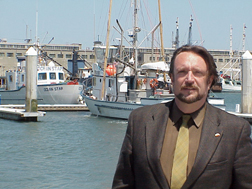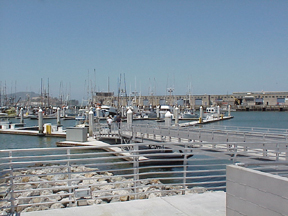Hyde
Street Harbor Set to Open June 9
The Official Take
John Davey, Maritime Operations
Manager, Port of
San Francisco on the New Hyde
Street Fishing Harbor.
 |
| John Davey,
Maritime Operations Manager, Port of San Francisco |
The new Hyde Street Fishing
Harbor is a long needed improvement to the facilities down at
Fishermen’s Wharf. Currently, what we have there is a fixed pier
configuration where the boats have to come in and tie up between
stall piles and use counter weights or a floating camel situation. A
floating camel consists of pilings with tires wrapped around them so
as to a bumper between the boat and the dock. It softens the
friction of the forces because they both have to rise and fall with
the tides.
The new Harbor has a modern
floating dock. It’s familiar to recreational boaters; the docks,
including the walkways and everything, float on the tides. It a
safer because fishermen won’t have to worry about lines getting
tangled and more convenient because of the walkway right alongside
the boats. Right now, the fisherman have to come in stern to the
tide so they can tie their sterns up along the wharf and come down a
ladder to get on their boat. That’s not so easy when you’re
lugging all your gear and provisions up and down a ladder. It can
get dangerous handing heavy things back and forth across the gap
between a vessel and the docks.
Also, the new harbor is
configured for larger berths. The original Fishermen’s Wharf was
built back in the 20’s and 30’s, when fishing boats were
smaller. The average length of a berth at the wharf right now is
about 35 feet. The smallest berth we have in the new harbor is 40
feet and we have a couple of 60 footers and even some 80 foot
berths. So now, we’ll be able to accommodate some of the larger
fishing vessels, which we haven’t been able to take into slips at
Fishermen’s Wharf. The larger ones currently have to tie alongside
Pier 45.
 |
| Bigger, better and
cleaner berths await hard-working fishermen |
We’ll have all new modern
utilities; electrical, water and such. There’s also a first-rate
system for handling bilge water so that it’ll be fed into the city’s
sewage treatment system. That will cut down almost entirely on gray
water and bilge water being discharged into the bay, and important
improvement in water quality for the harbor. There will be with a
much better security because we’ll have a single locked gate.
Currently with the fixed piers, there are probably as many ways to
get on the pier as there are boats. You can come from all different
directions, which makes security far more difficult to monitor.
We added 62 births. We currently
have about 120 so this increases the capacity by about 50%. A lot of
the fishing fleet is transient. They follow the fish, so they may be
home ported one place — Mendocino County, Oregon — but spend
upwards to a month or two in San Francisco, We’re planning in our
management to set aside about 25% of the berths strictly for
transients.
CONTINUE